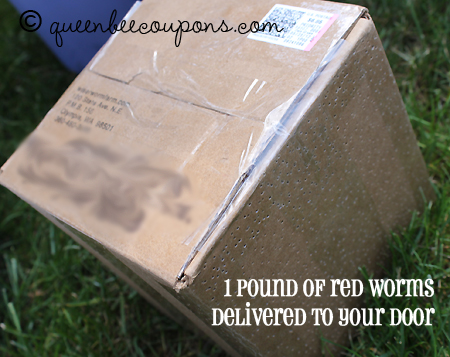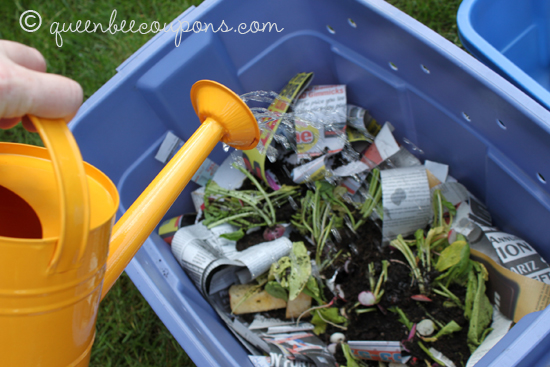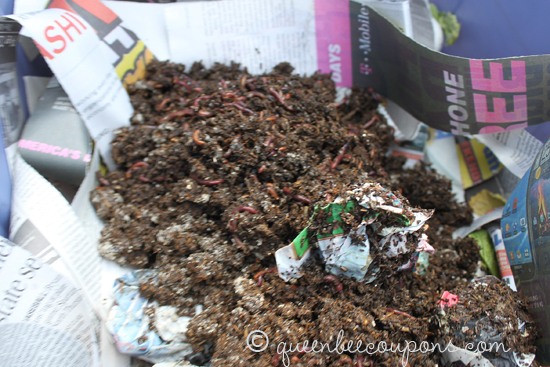
Find this post and other gardening/DIY tips on my Gardening Pinterest board
DIY Worm Compost Bin
I shared this post originally in May 2012 – but it’s one my most popular posts and I wanted to bring it back for those of you who haven’t seen it.
Worms creep me out. Sorry, it’s true. But I do have a four-year-old boy, so for better or worse, they have become a part of my reality as of late. I can’t touch them or even look at them too closely without getting the heebie-jeebies. But nobody can deny it – worms are good for eating food. Worms are good for composting! Worms are just generally helpful fellas – so I’m making a worm composting bin – and I’m going to show you how!
Believe it or not, my husband and I used to have a worm bin back when we were first married – it was a wedding gift from one of my bridesmaids (I have the coolest friends!). But for whatever reason that worm bin, made out of a rubbermaid tote, only lasted us a couple years before it turned into storage for our halloween decorations. 🙂 So we’re bringing it back and I’m going to show you how to make a Rubbermaid Worm Composting Bin!
What’s so great about worm composting? Worm composting is a fabulous way to take your family’s food waste and turn it into nutrient rich fertilizer for your garden or lawn. If you have a lot of space you could skip this whole worm composting thing and just create a big ole compost pile in your backyard. But compost piles aren’t for everyone – especially if you’re short on space. A worm compost bin can be a great way to take care of your food waste – but do it in a contained, mess-free, smell-free, easy-to-maintain system – that in-turn gives you rich soil amendments for your garden or yard.
 Mouse over image, top right to PIN this
Mouse over image, top right to PIN this
YOU’LL NEED:
- Red worms – about one pound
- Two (2) 8-10 gallon Rubbermaid totes
- Power Drill
- A couple good size rocks or wood pieces for spacing
- Newspaper and cardboard
INSTRUCTIONS

1.) Get your worms, preferably Red Worms
I asked on the Queen Bee Facebook page – and all my Facebook friends recommended I order my worms from the Olympia Worm Guy – Wiser Worm Farm. Being local – this option made great sense to me and I promptly ordered one pound of Red Worms for $27. They came in the mail less than 24 hours later (don’t you love the the Worm Wide Web?) You might be thinking I could have easily went digging in my backyard – but I want Red Worms, not your typical earthworm. From what I read earthworms will eventually die if added to a compost bin. And besides, since I’m a little squeamish I’d rather just pay $27 and have a box of worms arrive on my front porch. So that’s what I did. Besides, you get about 500 Red Worms per pound – so I figure that’s only $0.05 cents each! What a deal, ha! 🙂
I also discovered Amazon carries worms, did you know this? Seriously is there anything they don’t sell?
- Red Wiggler Composting Worms 2lb Pack
– $29.95 (price subject to change) – plus about $10 shipping
- Uncle Jim’s Worm Farm 1,000 Count Red Wiggler Live Composting Worms
– $24.95 + $4.95 shipping
You might be able to worm your way out of out of paying them – and I welcome you to share those ideas in the comment section below! Either way – the end result is – you need worms. Preferably a hungry batch of Red Worms.
2.) Get your bins
As with most things you can buy a fancy composting bin from Amazon or you can make your own using a couple $5 Rubbermaid tote. I ended up using bins I already had in my garage! You want two (2) dark plastic (not see through) Rubbermaid totes that are between eight to 10 gallons. I’ll call these bin #1 and bin #2.
Bin #1 is going to hold the worms and compost. Bin #2 is basically just a drainage bin, for when the bin gets too wet. I don’t think it’s even entirely necessarily to have a second bin – as long as you watch the moisture level.

3.) Drill holes in sides of Bin #1
Along the top edge of Bin #1 you’re going to want to drill holes. These will be above your compost line and will allow for ventilation – essential to the happiness of your worms. I’m using the bin that was given to us many years ago – and it happens to have large holes. If you don’t have a large drill bit, you can drill many, many smaller holes. Another option I’ve seen is you can cut out a portion of the top lid and replace with mesh screen – not a bad idea, but I’d worry about rainwater leaking and this is a bit more time intensive.

4.) Drill holes in bottom of Bin #1
Using a 1/8 drill bit (small) you will drill holes in the bottom of your worm bin. Preferably drill them in the recessed or lowest parts of the bottom of the bin – because that’s where water would sit and ultimately drain. Don’t worry – you’re worms won’t try to climb out of these holes – as long as they have a happy environment with plenty of food, they don’t try to venture out.

5.) One your bin has holes, shred up some newspapers (not your coupons!) and add it to the bin. Then add some dirt (for grit, helps with digestion), add your food scraps, sprinkle with water. You don’t want it too wet – and a good way to know is if you squeeze your “bedding” and if it drips, it’s too wet.

6.) Add your worms. My worms came with an ample supply of dirt and newspaper – so I dumped it all in. Then I gave them a little bit of water to freshen them up. Not too much!
7.) Cover with another layer of newspaper and a wet piece of cardboard. This does two things – it keeps any fruit flies away and it keeps your worms happy because they love both wet cardboard and darkness.

8.) Place Bin #1 inside Bin #2 – Bin #2 is going to have a couple rocks in it, the same size – to hold bin #1 up a bit above the other – to keep your ventilation holes free flowing. You could also use pieces of wood or gravel – anything to elevate your worm bin (Bin #1) inside your drainage bin (Bin #2). I actually used a bigger Bin #1 – this helps as well.
9.) Placement – Keep bin in a relatively cool place. No colder than 35 degrees and no hotter than 80 degrees. This means in the heat of summer you should move it to the cool garage. Also, don’t put near vibrations, like a washer or dryer, worms don’t like shaking. If you have it outside, make sure it won’t fill with rain water – you’ll drown your poor worms. A garage, shed or covered patio would be perfect! Many people keep them in their homes – you don’t have to worry, as long as the worms are happy they won’t escape!
10.) Maintain! Add food waste as you have it. You are in business! Now just add food to your bin as it’s available. Keep an eye on your food levels and if it’s getting a little high – take a few days off. But red worms can eat their weight in food a day – so if you have a pound of worms, you can compost about a pound of food a day!
As far as harvesting your nutrient rich worm poop/compost – I’d say give it at least a couple months – then you can dump the bin out onto a tarp and harvest your good soil. It’s very concentrated stuff, so a little bit goes a long way – mix with water to make worm poop tea and use as a soil amendment!
FEEDING YOUR WORMS
- Worms love: Breads or other grains, coffee grounds and the filter, tea bags, fruits, vegetables, egg shells (they love these!)
- Worms do not like: Dairy (this means cheeses, milks, yogurt), fatty foods, meats, oils
That’s it! It really is that easy. As long as your worms are fed, they have plenty of ventilation and things are kept moist – you really can’t go wrong. Good luck!
TROUBLESHOOTING
If you set it up right it shouldn’t smell, the worms shouldn’t try to escape, you shouldn’t have fruit flies and it should require very little maintenance. If you are having some of these problems – here’s what you need to likely fix:
- Worms are trying to escape or they are dying – your bin is probably too wet, too dry or needs more bedding. If you squeeze the bedding and it “drips” it’s probably too wet.
- Smelly bin – Too much food, your bin needs more ventilation or your bin is too wet. You can stop adding food for a couple weeks so the worms can catch up. Drill additional holes for ventilation. Replace very wet bedding with just “damp” bedding.
- Fruit flies – Not enough bedding. Keep your food covered with a layer of shredded newspaper at all times.

This is a fantastic resource to getting your worm bin set up – Worms Eat My Garbage: How to Set Up and Maintain a Worm Composting System (Amazon)
And of course, the best resource of all on worms – a 4-year-old boy.
He’s awfully proud of his “tutorial” so check it out!
If you don’t see the video – you can view it here: 4-year-old give worm bin tutorial
Like this post? PIN it!
*Like Queen Bee Coupons on Facebook for future updates!
* Subscribe to my daily email and be entered to win $100!
My disclaimer: I’m not a worm compost expert, although I have done a ton of research and I really did create this worm composting bin for our home use, but I’m not really the worm expert.
If you prefer to buy one ready to go, Amazon has this Worm Factory DS3GT 3-Tray Worm Composter, Green and a bunch of other designs. You can get a complete set up for about $60-$100, and some much fancier than that.
I’d love to hear from you – do you have a worm compost bin? Do you think you’ll start one? Do you have questions about worm composting?







Thank you so much for the tutorial! I have carefully went Over it time and time again. Now have a 1/4 lb of worms on my back porch 🙃 son and husband only see it for fish bait. But definitely a win win.
I am most definitely going to start worm composting. I have built a grow room in my basement to grow flowers and other plants. The compost will help me feed my plants and after the growing season the plants will help feed my worms.
OH. MY. GOODNESS. He is the cutest! I’m starting my worm bed this weekend!! Thanks for the handy instructions!!!
Can you use red worms from a bait shop for the worm compost?
What do yo do with the worm bens in the winter. I live in Colorado. Do the worms reproduce during the winter months? If you are able to keep the bens over the winter and the worms reproduce can you put extra worms out in your garden soil?
I keep a smaller bin (9”x11”) indoors over winter. My outdoor bin (48”x40”) I make sure to top off with almost finished compost and put a heating pad in it to keep the worms working over winter. As far as worms in the garden, if your garden is full of organic material and you keep it mulched with leaves or straw or even shredded paper, the worms and eggs put in in the spring should thrive. The worms will most likely die in winter, but the eggs will hatch when the conditions are right and food (compost and/or mulch) is available.
When its time to harvest your compost is there a way to save the worms for another batch other than picking them out or do you just buy more?
Get some 1/4” hardware cloth and some 2×4(or any scrap lumber) and build a soil sifter. It will not only separate most of your worms, it also breaks up your castings into smaller bits.
I just wanted to say that I saw this blog post on Pinterest two weeks ago and now I have 2 lbs of worms in plastic tote on my deck! Thank you so much for writing such a clearly written, easy to follow post on making a worm bin. Worm composting is something I’ve wanted to do for a while, but it seemed complicated enough that I was always too intimidated to try it, until I read your post. Thanks so much for taking the time to write it!
Cutest thing I’ve seen in a very long time! Thank you for sharing!
Hi! I love your tutorial! Just one question. How do I harvest and what am I supposed to harvest?
What is the faucet for? (In the amazon worm bin)
You will harvest the droppings. When the dirt gets a dark color it is ready. You can dump it all out and separate the worms or put the food on one side and wait a couple of days for them to move towards it and harvest the opposite. If a few worms are still left that is fine. The faucet is to drain the excess water or worm tea which is rich in nutrients. You don’t want to drown the worms or have things rot.
just had to say that I love the tutorial. So informative and so adorable!! And kudos to you for letting him explore this 😊